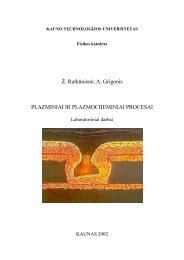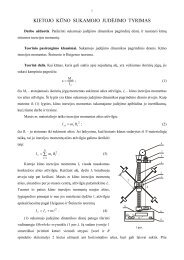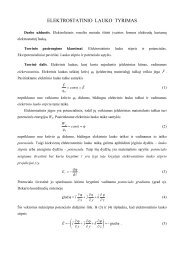PROCEEDINGS OF THE 7 INTERNATIONAL ... - Fizika
PROCEEDINGS OF THE 7 INTERNATIONAL ... - Fizika
PROCEEDINGS OF THE 7 INTERNATIONAL ... - Fizika
Create successful ePaper yourself
Turn your PDF publications into a flip-book with our unique Google optimized e-Paper software.
C.-M. Nilsson / Medical Physics in the Baltic States 7 (2009) 60 - 63<br />
together with another medical physicist to minimize the<br />
risks for mistakes.<br />
Fig. 3. In house built water phantom for measurements of<br />
absolute dose. Room for an ion-chamber is also seen.<br />
In the larger annual services that lasts a week, a large<br />
water tank (see Fig. 4) is used to take up dose profiles<br />
and depth doses. These are compared with the results of<br />
previous measurements of absorbed dose in the water<br />
tank and also the profiles taken up previously.<br />
Depth dose and profiles for open and wedge fields,<br />
absolute dose, TMR 20 10, and R50 are measured. These<br />
services also include preventive exchanges on the<br />
accelerators for example if one sees a MLC leaf<br />
beginning to falter, one exchanges it beforehand, or<br />
lubricates etc, all to keep the accelerator working<br />
properly.<br />
Fig. 4. Water tank from IBA, where an electrometer, diode,<br />
computer etc. is connected.<br />
Patient Specific QC<br />
IMRT QC<br />
QC of IMRT is performed before each patient starts<br />
his/her treatment. The plan is exported and calculated<br />
on a phantom, IBA MatriXX (see Fig. 5).<br />
62<br />
Fig. 5. IMRT phantom from IBA, with MULTICube<br />
polystyrene.<br />
The phantom is then irradiated in two ways. One series<br />
of irradiations where the phantom is irradiated in gantry<br />
and collimator 0 ◦ which is to check the fluence from the<br />
accelerator. The second irradiation is performed as if the<br />
phantom was the patient, and then each field is summed<br />
up to give a view of the complete dose to the<br />
patient/phantom. Then the measured and calculated<br />
dose distribution on the phantom is compared using γ<br />
evaluation and a visual comparison of the profiles. We<br />
use the criteria 3% and 3mm in our γ evaluation.<br />
In vivo QC<br />
For an in vivo system it is important to check initially<br />
that the system is stable and constant over time. This<br />
can be made that one irradiates the diodes 10-15 times<br />
and the spread should be within 0.5%. The<br />
measurements should be remade at different days for 1-<br />
2 weeks to see that the diodes are constant.<br />
3. Results<br />
We have an uptime of 97-98%. Using the in house made<br />
Excel sheet the physicist can follow the output from the<br />
daily QA check as can be seen in Fig. 6 for 4 MV<br />
photons and in Fig. 7 for 10 MV photons.<br />
Fig. 6. Per cent deviation from reference output in the daily<br />
morning QA for 4 MV photons.








